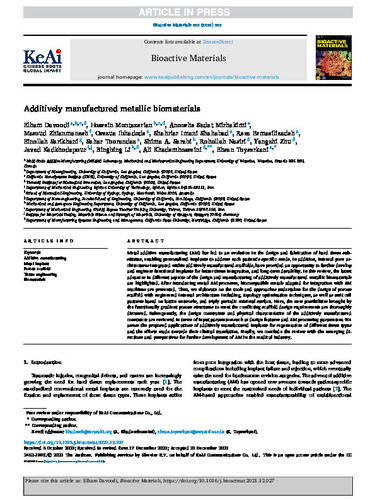| dc.contributor.author | Davoodi, Elham | |
| dc.contributor.author | Montazerian, Hossein | |
| dc.contributor.author | Mirhakimi, Anooshe Sadat | |
| dc.contributor.author | Zhianmanesh, Masoud | |
| dc.contributor.author | Ibhadode, Osezua | |
| dc.contributor.author | Shahabad, Shahriar Imani | |
| dc.contributor.author | Esmaeilizadeh, Reza | |
| dc.contributor.author | Sarikhani, Einollah | |
| dc.contributor.author | Toorandaz, Sahar | |
| dc.contributor.author | Sarabi, Shima A. | |
| dc.contributor.author | Nasiri, Rohollah | |
| dc.contributor.author | Zhu, Yangzhi | |
| dc.contributor.author | Kadkhodapour, Javad | |
| dc.contributor.author | Li, Bingbing | |
| dc.contributor.author | Khademhosseini, Ali | |
| dc.contributor.author | Toyserkani, Ehsan | |
| dc.date.accessioned | 2022-01-26 21:19:32 (GMT) | |
| dc.date.available | 2022-01-26 21:19:32 (GMT) | |
| dc.date.issued | 2021-12 | |
| dc.identifier.uri | https://doi.org/10.1016/j.bioactmat.2021.12.027 | |
| dc.identifier.uri | http://hdl.handle.net/10012/17991 | |
| dc.description.abstract | Metal additive manufacturing (AM) has led to an evolution in the design and fabrication of hard tissue substitutes, enabling personalized implants to address each patient's specific needs. In addition, internal pore architectures integrated within additively manufactured scaffolds, have provided an opportunity to further develop and engineer functional implants for better tissue integration, and long-term durability. In this review, the latest advances in different aspects of the design and manufacturing of additively manufactured metallic biomaterials are highlighted. After introducing metal AM processes, biocompatible metals adapted for integration with AM machines are presented. Then, we elaborate on the tools and approaches undertaken for the design of porous scaffold with engineered internal architecture including, topology optimization techniques, as well as unit cell patterns based on lattice networks, and triply periodic minimal surface. Here, the new possibilities brought by the functionally gradient porous structures to meet the conflicting scaffold design requirements are thoroughly discussed. Subsequently, the design constraints and physical characteristics of the additively manufactured constructs are reviewed in terms of input parameters such as design features and AM processing parameters. We assess the proposed applications of additively manufactured implants for regeneration of different tissue types and the efforts made towards their clinical translation. Finally, we conclude the review with the emerging directions and perspectives for further development of AM in the medical industry. | en |
| dc.description.sponsorship | National Institutes of Health || The Natural Sciences and Engineering Research Council of Canada || Network for Holistic Innovation in Additive Manufacturing | en |
| dc.language.iso | en | en |
| dc.publisher | Elsevier | en |
| dc.relation.ispartofseries | Bioactive Materials; | |
| dc.rights | Attribution-NonCommercial-NoDerivatives 4.0 International | * |
| dc.rights.uri | http://creativecommons.org/licenses/by-nc-nd/4.0/ | * |
| dc.subject | additive manufacturing | en |
| dc.subject | metal implant | en |
| dc.subject | porous scaffold | en |
| dc.subject | tissue engineering | en |
| dc.subject | biomaterials | en |
| dc.title | Additively manufactured metallic biomaterials | en |
| dc.type | Article | en |
| dcterms.bibliographicCitation | Davoodi, E., Montazerian, H., Mirhakimi, A. S., Zhianmanesh, M., Ibhadode, O., Shahabad, S. I., Esmaeilizadeh, R., Sarikhani, E., Toorandaz, S., Sarabi, S. A., Nasiri, R., Zhu, Y., Kadkhodapour, J., Li, B., Khademhosseini, A., & Toyserkani, E. (2021). Additively manufactured metallic biomaterials. Bioactive Materials. https://doi.org/10.1016/j.bioactmat.2021.12.027 | en |
| uws.contributor.affiliation1 | Faculty of Engineering | en |
| uws.contributor.affiliation2 | Mechanical and Mechatronics Engineering | en |
| uws.typeOfResource | Text | en |
| uws.peerReviewStatus | Reviewed | en |
| uws.scholarLevel | Faculty | en |
| uws.scholarLevel | Post-Doctorate | en |
| uws.scholarLevel | Graduate | en |


